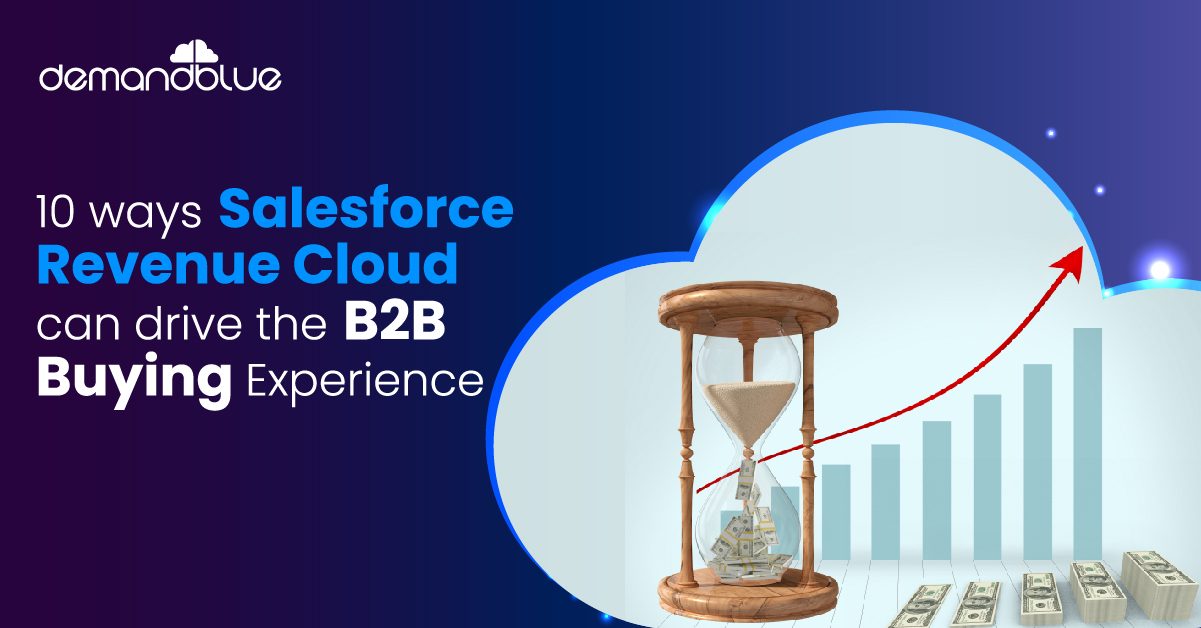
10 Ways Salesforce Revenue Cloud can Drive the B2B Buying Experience
We are living in a changed world. The pandemic has disrupted sales channels and customer demands. The need for technology to accelerate revenue generation, unify processes and provide customers with a frictionless buying experience has never been more necessary or urgent.
Salesforce Revenue Cloud offers industry-oriented solutions that address the key concerns of organizations – revenue growth, customer experience and sales enablement.
Let’s look at 10 ways Salesforce Revenue Cloud can drive the B2B revenue process and reshape the overall buying experience.
1. Salesforce Revenue Cloud streamlines and accelerates the lead-to-cash lifecycle. By focusing on the total revenue lifecycle businesses can provide a great user experience from the first sales call to multiple touchpoints across invoicing and billing. It is all part of the end-to-end revenue management approach enabled through Revenue Cloud.

![]() Don't forget to check out: Why Do You Have to Learn Salesforce & How Will it Assist You in Your Career Growth in 2021
Don't forget to check out: Why Do You Have to Learn Salesforce & How Will it Assist You in Your Career Growth in 2021
2. Revenue Cloud significantly reduces the number of integrations and manual processes that are needed for each stage of the customer’s revenue journey. By leveraging the Customer 360 platform and unifying the customer experience your business can gain a competitive edge.
3. Salesforce Revenue Cloud doesn’t require you to create a separate integration. All the orders and quotes are created within Salesforce and are converted into required subscriptions and invoices. This eliminates the integration need for syncing invoices, account balance information, and subscription details, etc.
4. It creates a unified view of customer information, including a historical list of invoices, active subscriptions from Sales and Finance data, which provides visibility and avoids revenue leakage.
5. Salesforce Revenue Cloud helps businesses to analyze billing information, timeliness of payment, all active subscriptions, and more under the sales team which helps to define a discount strategy for each Quote-to-Cash rule through defined metrics.
6. Revenue Cloud enables users to create their own customizable billing engine that can increase overall customer satisfaction. Automation of the billing & invoicing process as well as tracking recurring revenue on one platform once again provides the seamless experience business customers are expecting today.
7. Partners can use Salesforce Revenue Cloud as the ideal tool to offer strategic discounts for end-users based on their preferences. The ability to create branded partner portals and extend Salesforce Configure, Price, Quote (CPQ) to partners improves forecasting and builds trust across partners and customers.
![]() Check out another amazing blog by Demandblue here: How DemandBlue Helped a Leading Mortgage Lending and Refinancing Company To Strategize New Lead Assignment Process With Use of On-demand Salesforce Solution
Check out another amazing blog by Demandblue here: How DemandBlue Helped a Leading Mortgage Lending and Refinancing Company To Strategize New Lead Assignment Process With Use of On-demand Salesforce Solution
8. Visibility and reporting across the full revenue journey for is a key function across having CPQ, billing, delivery operations, contract management etc. On one platform. Being able to spot trends or issues quickly while viewing trusted data can have a huge impact on the bottom line.
9. Revenue cloud users can utilize data from different channels under a single platform with multi-cloud billing functionality. It helps corporations quickly set up cloud workflows for revenue packages.
10. Through several powerful extensions available in the AppExchange, Revenue Cloud can be extended to manage the entire revenue lifecycle. This can include taxation, pricing, billing payments, contract management and much more.
Do you want to know more about Revenue Cloud? Head here




Responses